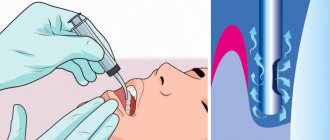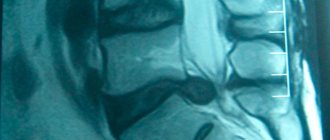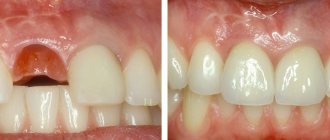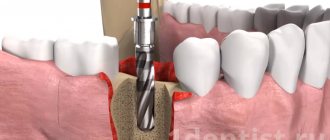Signs of alveolitis
The following symptoms indicate alveolitis of the socket:
- Socket pain that continues or renews on the 3-5th day after tooth extraction. In an uncomplicated postoperative period, it resolves in 1-2 days. At the beginning of the disease it is aching and becomes more intense after eating. At a later stage, the pain is constant and cannot be tolerated; painkillers help for a short time. It can radiate into the ear, into the temple on the side of the sore hole.
- The appearance of a bitter taste and putrid odor from the mouth.
- Enlargement and tenderness of the submandibular lymph nodes.
Upon examination, when alveolitis has just begun, the dentist discovers:
- redness of the gums,
- contents in the form of remains of a loose blood clot, food particles, saliva in the wound,
- that the hole is “dry”;
- in the midst of inflammation:
- swollen red mucous membrane along the edges of the hole,
- soreness when touched,
- there is a gray or yellowish coating on the walls.
Why you don't need to remove white plaque
Careless performance of oral hygiene procedures can cause damage or removal of the protective film. A number of negative processes result from the destruction of the barrier:
- Opening a wound for access of pathogenic microorganisms that provoke inflammation and infect the body’s circulatory system;
- Increased pain caused by the sensitivity of unprotected tissues to any form of external influence;
- Reopening of bleeding and increasing the duration of healing of the alveolar socket.
Accidental damage can be avoided by following medical recommendations.
How to maintain the integrity of white plaque after tooth extraction?
Reducing the risk of developing complications that occur against the background of exposure of the tooth extraction site involves following the following instructions:
- Abstain from drinking and eating for three hours from the end of the operation;
- Avoiding increased temperature in the affected gum area, including overheating as a result of taking a bath or visiting a sauna;
- Temporary cessation of bad habits, including smoking and drinking alcohol;
- Observe a daily break in relation to the procedure of rinsing the mouth and brushing the teeth;
- Reduce physical activity for the entire recovery period.
In situations where the pain after removal of the unit remains noticeable and causes severe discomfort, it is permissible to take painkillers prescribed by the attending physician. If you detect uncharacteristic discharge, which is a liquid mass, the spread of swelling to the gum tissue, as well as an increase in temperature to 38 degrees, you should immediately seek help, since these symptoms may indirectly indicate the development of infection or complications.
Causes of alveolitis
Normally, after a tooth is removed, a clot of blood cells and fibrin, the protein from which a blood clot is built, forms in the socket. It almost completely covers the bottom and walls of the alveoli. The clot serves as a mechanical barrier, biological protection against infection and additional injury to the wound surface. In this case, healing occurs by primary intention. The wound is slowly filled first with loose tissue, then with denser connective tissue, and later with young bone.
But there are situations when the healing process is disrupted.
Inflammation of the socket occurs if:
- The operation was highly traumatic, which reduced the protective capabilities of one’s own tissues;
- The blood clot, as the main defense, is broken or completely absent (“dry socket”):
- prolonged bleeding;
- early destruction of the clot;
- non-compliance with the rules of care (for example, increased rinsing, eating hard or too hot food soon after surgery);
- Tooth extraction was carried out for emergency reasons due to an acute infectious process: periodontitis or periodontitis with complications;
- There are common reasons:
- reduced immunity;
- blood clotting disorder;
- elderly age;
- lack of proper dental hygiene.
Why bone material may “come out” after surgery
Sinus lifting is an operation to increase bone tissue when there is a lack of it in the area of the maxillary sinuses. It is carried out with the aim of creating a solid foundation for reliable fixation of the dental implant. The basis of this foundation is bone material, which is produced in the form of granules. It is inserted into the artificially created space between the lining of the maxillary sinus and the periosteal layer of the jaw (for this, the sinus lining is lifted).
In the first 10-14 days, the material is still plastic and capable of deformation and exposure. It is very rare, but it still happens that after surgery, bone chips appear in the oral cavity, exit through the nasal passage or from the nasopharynx. This indicates a violation of the surgical protocol or non-compliance by the patient with the rules of the postoperative period.
Diagnosis and treatment of alveolitis of the socket after tooth extraction
If you have had a tooth removed, but after 2 days the pain in the socket has not gone away, or additional signs of inflammation have appeared, you should not postpone your visit to the doctor. Self-medication can lead to complications such as periostitis, osteomyelitis, and damage to adjacent teeth. The sooner treatment begins, the faster and with less risk of unpleasant consequences the wound will heal.
Even if your tooth was removed in another clinic, our specialists will help you.
Typically, diagnosing alveolitis of the tooth socket is not difficult. A medical history and examination is sufficient. But if necessary, to clarify the depth of the lesion, you may be prescribed additional studies: radiography or radiovisiography.
SM-Dentistry uses only high-quality materials; all instruments are sterilized using powerful sterilizers that eliminate the possibility of infection.
Treatment measures for alveolitis at SM-Dentistry:
- Local anesthesia will relieve acute pain and help you endure treatment.
- Complete cleansing of the wound from parts of the destroyed blood clot, food debris, plaque - a clean wound surface should remain.
- Treatment with disinfectants, antimicrobial and anesthetic agents.
- Application of a special turunda (tampon with medications).
The doctor will give recommendations for further care:
- special baths with antiseptic;
- painkillers;
- gentle diet.
It is possible that treatment of socket alveolitis will need to be supplemented with physiotherapeutic methods.
Temperature increase
Tooth extraction usually does not cause an increase in temperature; in rare cases, there is an increase in temperature up to 37.5º in the first few hours after the operation, but this also goes away by the evening of the same day. If the temperature is higher and lasts longer, this may be a sign of an inflammatory process in the socket. In this case, you should immediately consult a doctor.
Prevention of alveolitis at SM-Dentistry
If the operation is not an emergency, then dentists first treat caries and other inflammatory diseases in the oral cavity, which can become a source of infection.
After the operation, you will receive detailed recommendations for caring for the socket so that the blood clot forms correctly and does not break down prematurely. To do this, you must follow a diet (do not eat hard or hot foods), do not use intensive rinsing and cleaning in the area of the injured hole, and use antiseptic and painkillers.
Sign up for a consultation with a dental surgeon by calling 24/7 in Moscow +7 (495) 777-48-06.
Dentist consultation Treatment of caries
Treatment and prevention of alveolitis
Treatment of alveolitis is carried out by a dentist; self-medication is unacceptable. Firstly, you may make a mistake with the diagnosis, as a result all manipulations will be ineffective. Secondly, traditional methods are not enough, and for professional ones you do not have enough experience and equipment.
How is treatment carried out at the clinic? The doctor numbs the wound, cleans it, and puts a tampon with medicine. If foreign bodies (shards of tooth, root, pieces of food) prevent the socket from healing, the dentist removes them. You may need to take antibiotics, undergo physical therapy, baths with medications, and follow a diet during healing (excluding hard, hot foods from the diet). In advanced cases, additional operations are required. Traditional methods are acceptable with the permission of a doctor. For example, rinses with sage, chamomile, burdock and others. These solutions can accelerate tissue healing and alleviate the patient's condition.
What measures exist to prevent inflammation? In the first days, do not eat hard or too hot foods, and do not rinse your mouth. These actions help flush out the clot, which can cause inflammation. If tooth extraction is not an emergency, it is advisable to take care of the treatment of caries and other oral diseases in advance. Give up bad habits during healing: alcohol thins the blood, which prevents the formation of a clot, tobacco increases the risk of infection of the hole. If your gums hurt on the first day after tooth extraction, you can simply take a painkiller.
Two days after tooth extraction, the pain has not subsided, it has intensified, and its character has changed, which means that you should definitely consult a doctor! Alveolitis does not go away on its own; it can only lead to unpleasant consequences and complicate further treatment. Monitor the condition of your teeth especially carefully if there were other diseases of the oral cavity or the body as a whole at the time of removal. Doctors at Comfort Dentistry give recommendations for further care after tooth extraction. They tell you how to treat gums after tooth extraction, and in what cases to contact a dentist. If you doubt the correctness of self-diagnosis, you can call us and consult with a specialist.
Prices
| Name of service | Price, rub.) * |
| Initial consultation with a dentist-therapist | 1,500 rub. |
| Repeated consultation with a dentist-therapist | 800 rub. |
| Treatment of caries (imaging, anesthesia, isolation of the oral cavity, installation of an insulating lining and filling made of composite light-curing imported material) | from 4,350 rub. |
| Treatment of alveolitis with socket revision | 3,000 rub. |
We accept VISA, MASTERCARD, MAESTRO bank cards for payment.
Would you like us to call you back?
Alveolitis of the tooth: treatment
The treatment of alveolitis after tooth extraction must be taken seriously, since the disease will not go away on its own, and its consequences can be very serious:
- blood poisoning
- abscess
- osteomyelitis
- phlegmon
- periostitis
Only an experienced dental surgeon will create an effective treatment plan. It is better to start it when the first signs of the disease appear. The treatment process may include:
- numbing the affected area using anesthesia
- washing the hole with warm antiseptic solutions
- removing particles of tissue decay that remain after washing using a sharp surgical spoon
- treatment with a sterile cotton swab
- applying a gauze bandage with iodoform impregnation or an anesthetic and antiseptic bandage
- impregnation of soft tissues at the site of inflammation with anesthetic and lidocaine
- application of antiseptic tampons, hemostatic sponge with kanamycin
- removal of dead tissue
- microwave therapy, fluctuarization, infrared laser beams, ultraviolet irradiation
- prescribing vitamins, analgesics and sulfa drugs
- antibiotic therapy
With proper treatment of serous alveolitis, the inflammatory process subsides after 3–4 days.
A week after the pain disappears, the walls of the socket begin to heal and become covered with new mucous tissue. After 14 days, the swelling subsides and the mucous membrane takes on a normal pink color. After treatment of purulent alveolitis, the wound heals within 1–2 months, and tissue restoration takes about six months.











